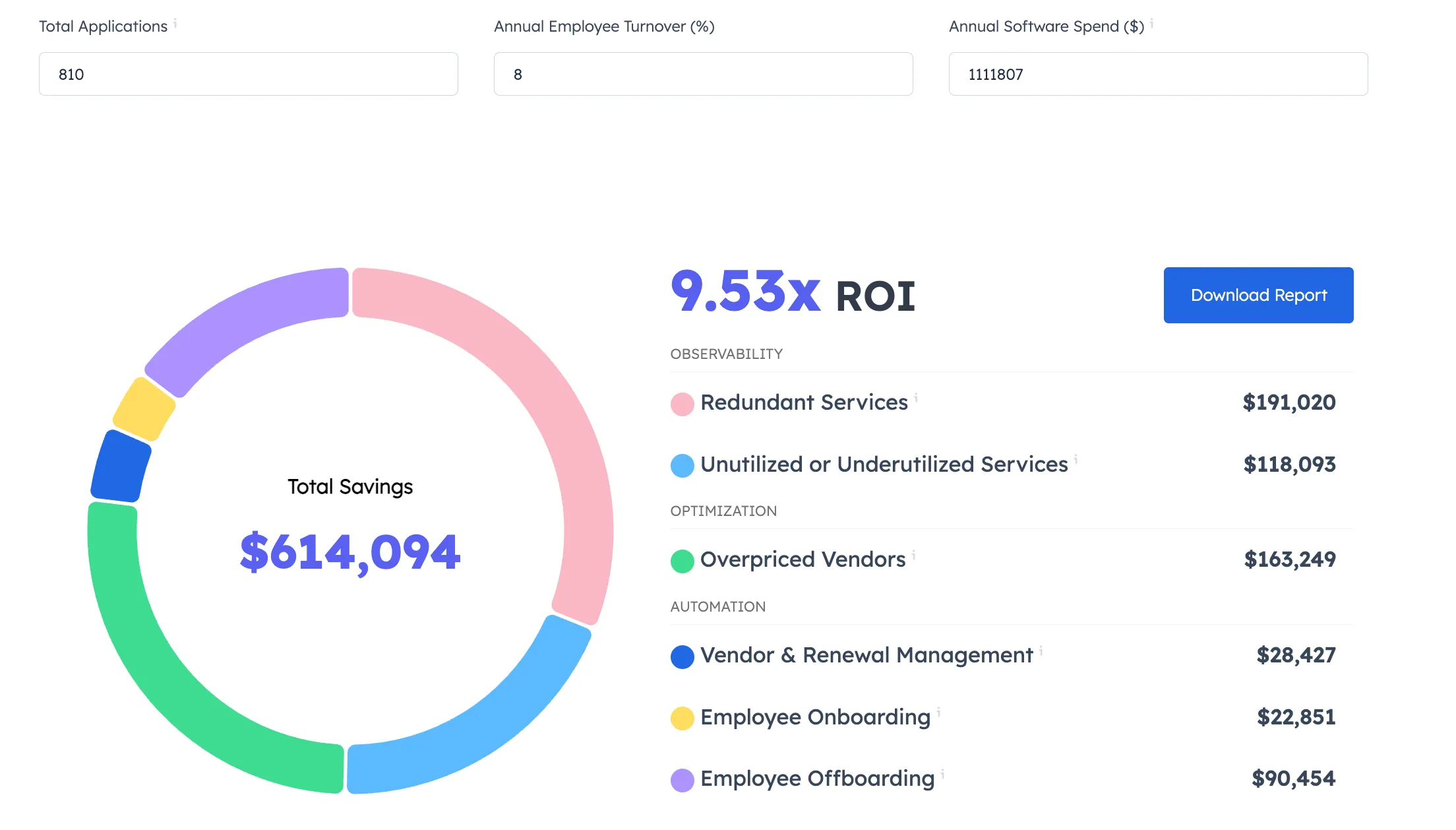In this day and age, cloud adoption paved the way for ease in SaaS implementation within an organization. Back in the day, it took weeks to procure an application within the business ecosystem and a few more days to install and license it to the required users. Fast forward to the present, you can sign up for any app, build workflows, and reap the ROI from day 1.
But here is the challenge. Signing up for SaaS applications became easy, but managing all the app spending became hard, leading to overspending. In this blog, we speak about how to break free from overspending.
Key Takeaways:
SaaS Spend Management platforms help you with,
- Centralizing all subscriptions and the contracts associated with the apps.
- Understanding the total cost and spending associated with the apps.
- Identifying underused, unused, sub-optimal, and inactive licenses.
- Removing redundant applications from the SaaS ecosystem to cut costs.
[Exclusive] The State of SaaS Management 2024 report, download now!
What is SaaS Spend Management?
SaaS spend management is having a holistic view and managing your organization's spending on SaaS applications. It includes identifying the SaaS application present in your ecosystem, right-sizing the number of licenses and entitlements for deriving the best value, and cutting costs due to unsupervised renewals.
Excessive Spending comes in 4 ways:
1. Increase in duplicate applications (Shadow IT)

Different departments often use different tools to solve the same problem. They not only abandon the IT-prescribed tool but tend to sign up for various tools with the same functionality. On the other hand, shadow IT applications keep growing because there is no centralized tracking of applications used within an organization.
2. Un-revoked applications

There are no logs on who and which department uses what applications. Since there isn’t a centralized dashboard and most of the employees use applications without the knowledge of IT, they are either hesitant or forget to inform the IT department. This leads to paying for unused applications.
3. Un-revoked licenses

When an employee leaves the company, it is the due diligence of the IT department to revoke the licenses, but IT teams are blindsighted on the applications that are in use. This means the transactions keep happening from the company credit card.
4. Unused enterprise pricing

Applications that charge per employee cost less as the employee count increases. For example, say the number of licenses per user costs $10, but for an organization with 1000+ employees, the application is offered at $8 per license.
Employees who purchase licenses independently tend to overspend without knowing the enterprise-level discounts.
How big is the SaaS spend management market?
The global SaaS spend management market size was valued at US$ 611 million in 2022 and is projected to reach US$ 2456.8 million by 2029, growing at a CAGR of 22.0% from 2023 to 2029.
IT spending is growing every year, and we found through our "State of SaaS Management" white paper that SaaS occupies nearly 6-10% of the budget for 31% of IT decision-makers.
Why is SaaS Spend Management important in 2024?
#1. Manages the shift in SaaS Decision-Makers
Earlier, IT used to test every tool before rolling it out to the organization. Now, as the purchasing power is in the hands of the employees, they tend to get applications without the knowledge of the IT department.
The marketing department finds Slack an easy collaboration tool and informs the Product department about it. The IT-prescribed Microsoft Teams will be abandoned if they shift to
Slack. This will lead to runaway costs and unmanaged spending as you keep spending on Microsoft Teams.
#2. Eliminates SaaS Wastage
You can save much of your SaaS budget if you eliminate SaaS wastage. The first step is to check the apps in your inventory and determine whether you should spend money on them, whether they bring value to your organization, and whether everyone utilizes them.
Even though your employees get them to benefit your company, you need to ensure that there is no app duplication, abandoned applications, or underutilized applications.
#3. Saves time spent on audits
What would you do if you needed to take an audit of all the SaaS applications that you are paying for? Where would you start from? If you are maintaining a spreadsheet to manage this, it will undoubtedly take weeks.
On top of it, do you know if it is up to date? What if your employees had purchased a new app recently and had forgotten to update it? Without a dedicated tool, these processes could consume a lot of productive hours.
A former IT administrator of Lucchese, a boot manufacturing company, was fired, and he took his frustration out on the system by shutting down servers, deleting essential files, and causing immense damage to the company's network.
#4. Streamlines the shift from On-premise to Cloud infrastructure
Gone are the days when we used to install Microsoft Office on computers using CDs. With SaaS emergence, prominent software like Adobe, Microsoft, Oracle, and many more have taken their products to Cloud-only deployments.
Anyone can sign up for these and start using them from anywhere. This marks the shift from a network perimeter to a holistic identity perimeter.
#5. Showcases effective use of enterprise buying
Employees adopt SaaS without considering any centralized procurement strategy, as the cost of a single license is very low. But if one employee procures a license at $7.50, it would make little impact on the budget. But if hundreds and thousands of employees do the same, it would severely hit the budget.
Also, these employees don't leverage enterprise buying power while signing up for these applications. For example, look at this pricing of Trello:
Say a business unit of yours has opted for the Business class plan, and other business units have also opted for the Business class plan.
In this case, had these business units had the visibility, they could have opted for the enterprise plan, which would get them more features and cut the overall cost by leveraging the enterprise buying power. These vendors offer great discounts if you purchase these licenses in bulk.
Here’s the solution for effective Spend Management
1. Avoid Spend Management via spreadsheets
Spreadsheets are fine when you are a small organization with less than 25 employees, but when your company scales, so will the number of SaaS applications used.
Tracking who uses what application and how long they have used it is difficult when there are more users. The IT should be alerted when a new SaaS tool is purchased, but the information often gets lost in the shuffle. This is where a SaaS Spend management tool helps keep a constant log.
2. Evaluate user engagement metrics
User engagement metrics help you with how a user interacts with an app, if the user uses the features availed, if the employees are getting the value out of the application, and more.
To calculate the user engagement metrics, you need a tool to monitor the SaaS application’s usage. By measuring user engagement, you can determine the efficiency of the app. This data helps you understand whether an application is valuable to your organization or not.
3. Centralise every subscriptions
You can get bulk vendor discounts if you do a centralized application procurement. This starts with understanding the departments and their requirement.
Consolidating the requirements across teams helps map the plan on which a tool needs to be availed. The consistent synergy between teams via a centralized platform will help with efficient app requests.
4. Manage auto-renewals in advance
You can cut costs by canceling unnecessary subscriptions with overlapping functionality during renewals. It is necessary to decide whether you need an application before the renewal date or you may get locked due to auto-renewals.
Also, look for price negotiation opportunities or discounts in the upcoming renewals. With SaaS management software in place, you can set renewal notifications that alert you before a renewal is due.
5. Avoid Vendor Lock-ins
If you wish to switch to better alternative software, your existing vendor might increase the switching cost in hopes of making your stay. They have understood the logic that higher switching costs mean you are less inclined to move away from them.
They wouldn't bother about how costly or extensive the implementation is as they are sure that it is the only way to make you stay. Worst of all, some vendors even increase the renewal pricing as they know that you are trapped in a high-switching cost scenario.
Here’s why you need a SaaS Spend Management Software
Keeps track of SaaS Spends
A SaaS spend management tool audits your whole SaaS landscape and keeps you updated on the overall spend, how much is spent for an application, and who is using it. You can also see how efficiently it is used and whether other tools have overlapping functionality. This way, you can spot SaaS wastage and excessive spending and cut it off.
Helps in Budgeting and Forecasting
A SaaS spend management tool will alert you days before your renewal. This helps you decide whether to continue using an application or cancel your subscription. While allocating budgets, you can evaluate past budgets against spending + get a forecast of your expenditures for the coming financial year with a spend management tool.
Discovers and categorizes applications
A spend management tool can discover and categorize the applications available in your SaaS landscape.
The SaaS app info
- Name of the app and its vendor
- Its primary use and functions for your organization
The expense and spending details
- The total value of the contract that includes platform and implementation fees
- The frequency of billing
- Consumption metrics
Ownership Info
- Who bought the app-business unit/department/ employee?
- Number of users
- Cost center
License details
- Total number of licenses procured
- License type
- Cost of one license
Renewal Details
- License start date
- Renewal due
- Notification period
Manage your SaaS Spends With Zluri
Two significant reasons businesses shifted to the cloud are to save money on maintaining on-premise software and to have application management capabilities. But the ease with which one can procure SaaS in today's world can ironically burn a big hole in your pocket if this SaaS cost is not kept in check. This is where a SaaS management platform comes into play.

Zluri helps you with,
- Centralizing all subscriptions and the contracts associated with the apps.
- Understanding the total cost and spending associated with the apps.
- Identifying underused, unused, sub-optimal, and inactive licenses.
- Removing redundant applications from the SaaS ecosystem to cut costs.









.svg)














